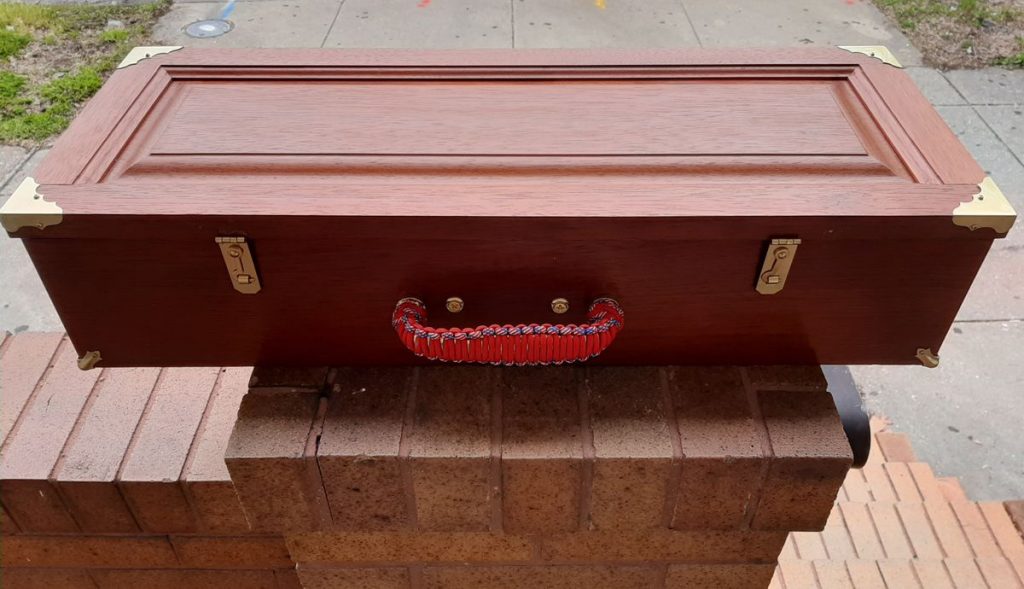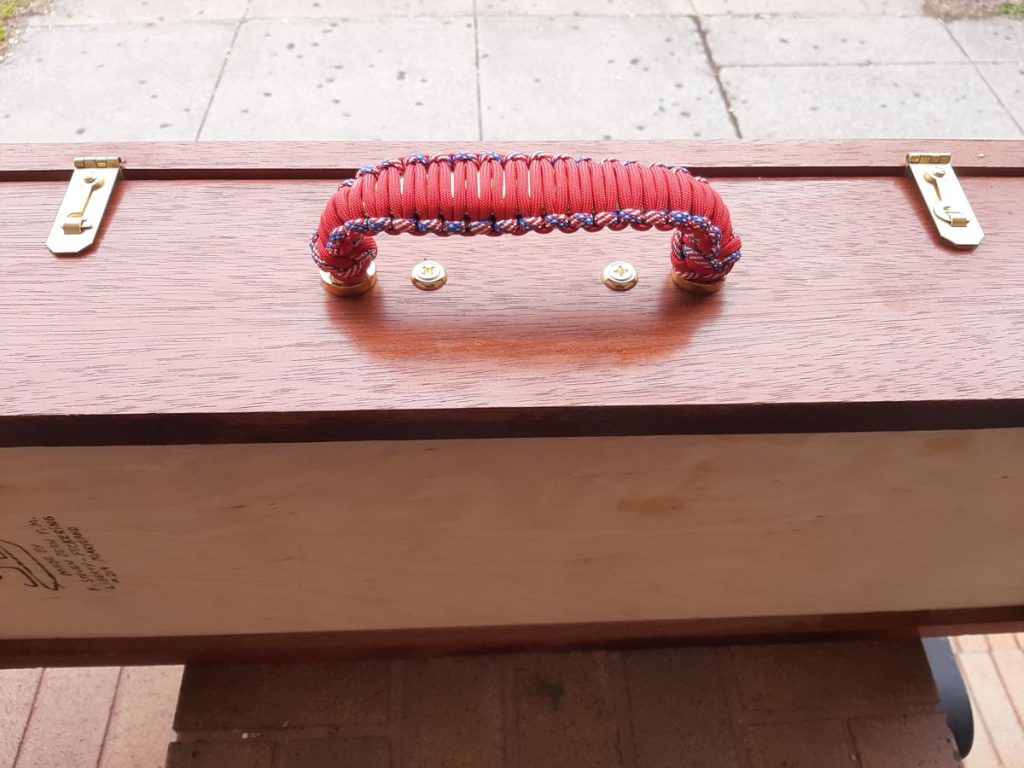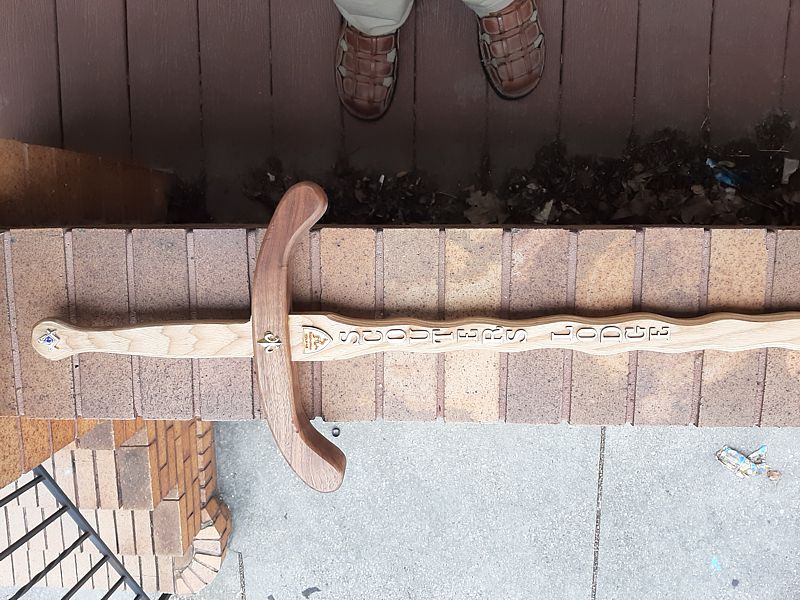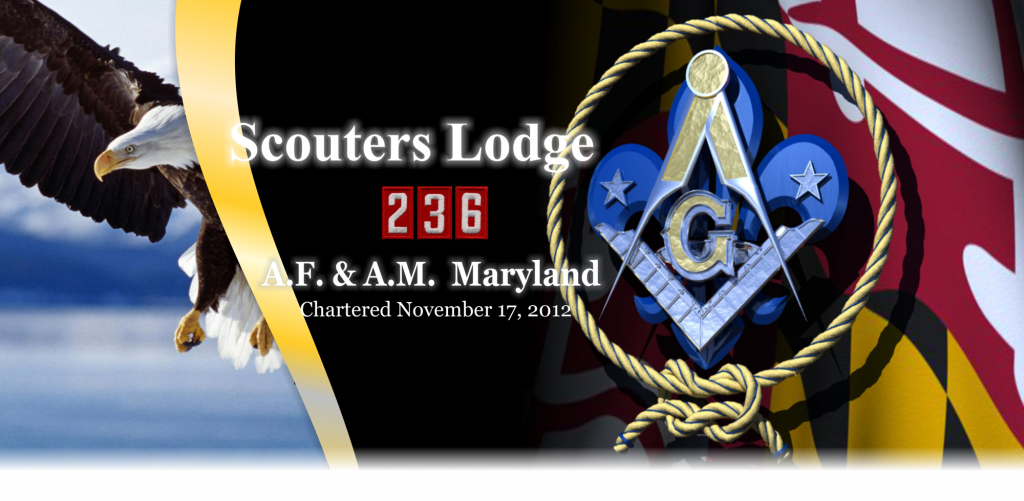Scouters Lodge #236 is happy to announce that we are providing up to four $450 camperships to Maryland Scouts in 2022. Please visit our campership page and fill out the application and send it in. Deadline for submissions is May 16th, 2022.
Traveling Gavel case improvements
The attached pictures are of the “casket” of the masonic Traveling Gavel Showing the “embellishments” that have been done to it. You can see the brass corners, the two brass “locking” hasps, the paracord-wrapped brass handle and the two escutcheons camouflaging two holes from a previous handle. You can use these pictures at next Thursday’s “virtual” lodge meeting to show our members what was done to leave our “mark” on the Traveling Gavel. Nothing was done to the gavel itself.

These pictures should illustrate what work was done on the “casket.” There were several small screw holes where the previous small (utterly useless) brass hasps were located. These holes have been filled with wood putty that matches the color of the wood (mahogany) used to make the “casket.” By the way, a “casket” is the term used for a small wooden chest or box used to hold something of importance/value, in this case, the Masonic Traveling Gavel. Like all good Scouts, we try to leave things better than we found them. In this particular case, “Leave No Trace” does not apply.

Scouters Lodge Tyler’s Sword
In Scouting, there is no need or use for a sword of any kind. The “biggest” blade that a Scout might use would be a kitchen knife in the preparation of food. With Freemasonry, things are a little different and a Lodge had a guard outside the lodge’s meeting place with a drawn sword to keep away “cowans and eavesdroppers.”
In Scouter’s Lodge 236, we have decided to use wood in a way to tie in those skills we learn in Scouting. I did some research on the internet about the Tyler’s Sword and found that most of the swords being used by Lodges are either military sabers or swords created commercially for use by fraternal organizations. Masonic tradition says that the Tyler’s Sword is to resemble the flaming sword(s) the G-d placed with angels at the Garden of Eden to guard against Adam and Eve from returning after being expelled. It would be interesting is we could design a sword that could actually have flames but we know that that would be ridiculous let alone very dangerous to people and property. Therefore, we have to come up with a “symbolic” flaming sword. History shows us that “flaming” swords were developed and used. These swords were, of course, made of steel but the blades, instead of being straight-edged, were made to have wavy-shaped blades. In Europe, this style of blade was called “flamberge.” These swords were quite large, sometimes as long as 4 to 5 feet long. They required a wielder of that sword to be quite large and strong. In the Far East, wavy-blade swords were also created but the were not so large and heavy as the European Flamberge swords. These swords are known as “kris.” The blades are quite lethal-looking and apparently are quite damaging not only when piercing a person’s body but also in the withdrawal of the blade.

Scouter’s Lodge 236 has taken the idea of the flamberge sword and had one created in wood. Our Tyler’s Sword has a wavy blade, I believe that the blade and hilt is oak and the cross-guard is black walnut. At the top of the hilt or pommel, we have added a square-and compasses pin. On the cross-guard, we’ve added a plain Scout fleur-de-lis pin. These pins are on both sides of the sword. Down one side of the blade, I found small wooden letters and have spelled out “SCOUTERS LODGE.” Our Scouter’s Lodge 236 Tyler’s Sword was crafted by Isle of Man Woodworking of Delta, Pennsylvania.
So, what is a Mason?
A
Mason is a man who has decided that he likes to feel good about himself
and others. He cares about the future as well as the past, and does
what he can, both alone and with others, to make the future good for
everyone.
Many men over many generations have answered the question,
“What is a Mason?” One of the most eloquent was written by the Reverend
Joseph Fort Newton, an internationally honored minister of the first
half of the 20th Century and Grand Chaplain, Grand Lodge of Iowa,
1911-1913.
So, what’s a Mason? When is a man a Mason?
When he
can look out over the rivers, the hills, and the far horizon with a
profound sense of his own Littleness in the vast scheme of things, and
yet have faith, hope, and courage — which is the root of every virtue.
When he knows that down in his heart every man is as noble, as vile, as
divine, as diabolic, and as lonely as himself, and seeks to know, to
forgive, and to love his fellowman.
When he knows how to sympathize with men in their sorrows, yea, even in their sins — knowing that each man fights a hard fight against many odds. When he has learned how to make friends and to keep them, and above all how to keep friends with himself. When he loves flowers, can hunt birds without a gun, and feels the thrill of an old forgotten joy when he hears the laugh of a little child. When he can be happy and high-minded amid the meaner drudgeries of life. When star-crowned trees and the glint of sunlight on flowing waters subdue him like the thought of one much loved and long dead. When no voice of distress reaches his ears in vain, and no hand seeks his aid without response. When he finds good in every faith that helps any man to lay hold of divine things and sees majestic meanings in life, whatever the name of that faith may be. When he can look into a wayside puddle and see something beyond mud, and into the face of the most forlorn fellow mortal and see something beyond sin. When he knows how to pray, how to love, how to hope. When he has kept faith with himself, with his fellowman, and with his God; in his hand a sword for evil, in his heart a bit of a song — glad to live, but not afraid to die! Such a man has found the only real secret of Masonry, and the one which it is trying to give to all the world
The word “lodge” means both a group of Masons meeting in some place and the room or building in which they meet. Masonic buildings are also sometimes called “temples” because much of the symbolism Masonry uses to teach its lessons comes from the building of King Solomon’s Temple in the Holy Land. The term “lodge” itself comes from the structures which the stonemasons built against the sides of the cathedrals during construction. In winter, when building had to stop, they lived in these lodges and worked at carving stone.
While there is some variation in detail from state to state and country to country.If you’ve ever watched C-SPAN’s coverage of the House of Commons in London, you’ll notice that the layout is about the same. Since Masonry came to America from England, we still use the English floor plan and English titles for the officers. The Worshipful Master of the Lodge sits in the East. “Worshipful” is an English term of respect which means the same thing as “Honorable.” He is called the Master of the lodge for the same reason that the leader of an orchestra is called the “Concert Master.” It’s simply an older term for “Leader.” In other organizations, he would be called “President.” The Senior and Junior Wardens are the First and Second Vice-Presidents. The Deacons are messengers, and the Stewards have charge of refreshments.
Every lodge has an altar holding a “Volume of the Sacred Law.” In the United States and Canada, that is almost always a Bible.
This is a good place to repeat what we said earlier about why men become Masons:
There are things they want to do in the world
There are things they want to do “inside their own minds.”
They enjoy being together with men they like and respect.
The Lodge is the center of these activities.
